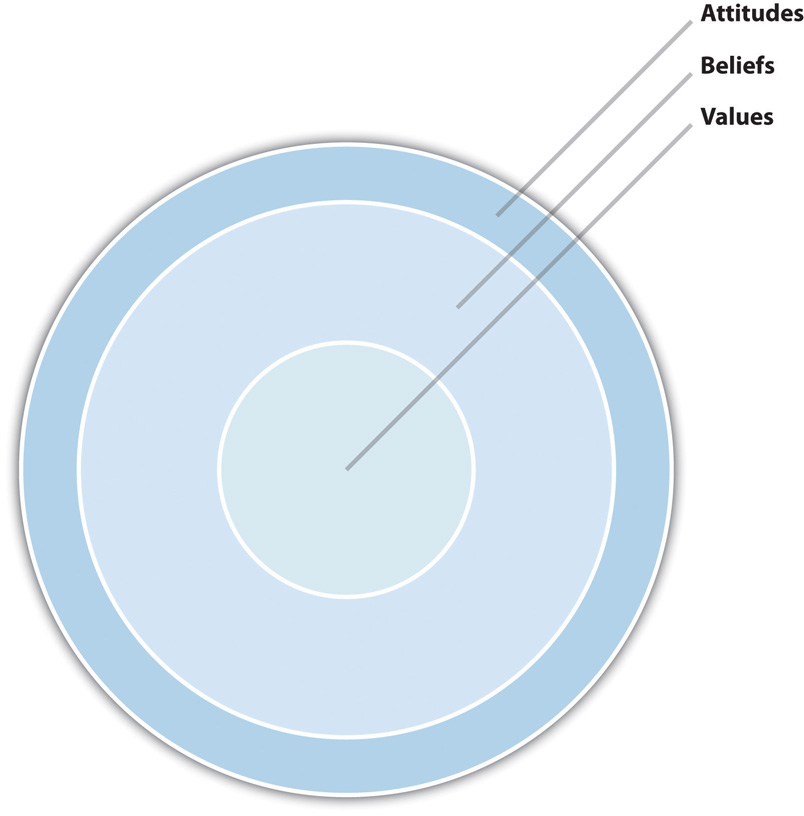18.1: Selecting and Narrowing a Topic
Learning Objectives
- Employ audience analysis.
- Determine the general purpose of a speech.
- List strategies for narrowing a speech topic.
- Compose an audience-centered, specific purpose statement for a speech.
- Compose a thesis statement that summarizes the central idea of a speech.
Many people do not approach speech preparation in an informed and systematic way, which results in poorly planned or executed speeches that are not pleasant to sit through as an audience member and don’t reflect well on the speaker. Good speaking skills can help you stand out from the crowd in increasingly competitive environments. While a polished delivery is important and will be discussed later in this chapter, good speaking skills must be practiced much earlier in the speech-making process.
Analyze Your Audience

Audience analysis is key for a speaker to achieve his or her speech goal. While there are some generalizations you can make about an audience, a competent speaker always assumes there is a diversity of opinion and background among his or her listeners. You can’t assume from looking that everyone in your audience is the same age, race, sexual orientation, religion, or many other factors. Even if you did have a fairly homogenous audience, with only one or two people who don’t match up, you should still consider those one or two people. When I have a class with one or two second-career students, I still consider the different age demographics even though thirty or more other students are eighteen to twenty-two years old. In short, a good speaker shouldn’t intentionally alienate even one audience member. Of course, a speaker could unintentionally alienate certain audience members, especially in persuasive speaking situations. While this may be unavoidable, speakers can still think critically about what content they include in the speech and the effects it may have.
Even though you should remain conscious of the differences among audience members, you can also focus on commonalities. When delivering a speech in a college classroom, you can rightfully assume that everyone in your audience is currently living in the general area of the school, is enrolled at the school, and is currently taking the same Advanced Professional Communication class. In professional speeches, you can often assume that everyone is part of the same professional organization if you present at a conference, employed at the same place or in the same field if you are giving a sales presentation, or experiencing the nervousness of starting a new job if you are leading an orientation or training. You may not be able to assume much more, but that’s enough to add some tailored points to your speech that will make the content more relevant.
Demographic Audience Analysis
Demographics are broad sociocultural categories, such as age, gender, race, socioeconomic status, sexual orientation, education level, religion, ethnicity, and nationality that are used to segment a larger population. Since you are always going to have diverse demographics among your audience members, it would be unwise to focus solely on one group over another. As a speaker, being aware of diverse demographics is useful in that you can tailor and vary examples to appeal to different groups. As discussed in the “Getting Real” feature in this chapter, engaging in audience segmentation based on demographics is much more targeted in some careers.
Psychological Audience Analysis
Psychological audience analysis considers your audience’s psychological dispositions toward the topic, speaker, and occasion and the ways in which their attitudes, beliefs, and values inform those dispositions. When considering your audience’s disposition toward your topic, you want to assess your audience’s knowledge of the subject. You wouldn’t include a lesson on calculus in an introductory math course. You also wouldn’t go into the intricacies of a heart transplant to an audience with no medical training. A speech on how to give a speech would be redundant in a public speaking class, but it could be useful for high school students or older adults who are going through a career transition.
The audience may or may not have preconceptions about you as a speaker. One way to positively engage your audience is to make sure you establish your credibility. You want the audience to see you as competent, trustworthy, and engaging. If the audience is already familiar with you, they may already see you as a credible speaker because they’ve seen you speak before, have heard other people evaluate you positively, or know that you have credentials and/or experience that make you competent. If you know you have a reputation that isn’t as positive, work hard to overcome those perceptions. To establish your trustworthiness, incorporate good supporting material into your speech, verbally cite sources, and present information and arguments in a balanced, noncoercive, and nonmanipulative way. To establish yourself as engaging, have a well-delivered speech, which requires you to practice, get feedback, and practice some more. Your verbal and nonverbal delivery should be fluent and appropriate to the audience and occasion.

The circumstances that led your audience to attend your speech will affect their view of the occasion. A captive audience includes people who are required to attend your presentation. Mandatory meetings are common in workplace settings. Whether you are presenting for a group of your employees, coworkers, classmates, or even residents in your dorm if you are a resident advisor, you shouldn’t let the fact that the meeting is required give you license to give a half-hearted speech. In fact, you should build common ground with your audience to overcome any potential resentment for the required gathering.
In your Advanced Professional Communication class, your classmates are captive audience members. View having a captive classroom audience as a challenge, and use this space as a public speaking testing laboratory. You can try new things and push your boundaries more, because this audience is very forgiving and understanding, since they have to go through the same things you do. In general, you may have to work harder to maintain the attention of a captive audience. Since coworkers may expect to hear the same content they hear every time this particular meeting comes around, and classmates have to sit through dozens and dozens of speeches, use your speech as an opportunity to stand out from the crowd or from what’s been done before.
A voluntary audience includes people who have decided to come to hear your speech. This is perhaps one of the best compliments a speaker can receive, even before they’ve delivered the speech. Speaking for a voluntary audience often makes speakers have more speaking anxiety, because they know the audience may have preconceived notions or expectations that they must live up to. This is something to be aware of if you are used to speaking in front of captive audiences. To help adapt to a voluntary audience, ask yourself what the audience members expect. Why are they here? If they’ve decided to come and see you, they must be interested in your topic or you as a speaker. Perhaps you have a reputation for being humorous, being able to translate complicated information into more digestible parts, or being interactive with the audience and responding to questions. Whatever the reason or reasons, it’s important to make sure you deliver on those aspects. If people are voluntarily giving up their time to hear you, you want to make sure they get what they expected.
A final aspect of psychological audience analysis involves considering the audience’s attitudes, beliefs, and values, as they will influence all the perceptions mentioned previously. As you can see in Figure 18.1.1 “Psychological Analysis: Attitudes, Beliefs, and Values”, we can think of our attitudes, beliefs, and values as layers that make up our perception and knowledge.

At the outermost level, attitudes are our likes and dislikes, and they are easier to influence than beliefs or values because they are often reactionary. If you’ve ever followed the approval rating of a politician, you know that people’s likes and dislikes change frequently and can change dramatically based on recent developments. This seesaw of attitudes can be useful for a speaker to consider. If there is something going on in popular culture or current events that has captured people’s attention and favor or disfavor, then you can tap into that as a speaker to better relate to your audience. Be careful if the issue is highly controversial, though.
When considering beliefs, we are dealing with what we believe “is or isn’t” or “true or false.” We come to hold our beliefs based on what we are taught, experience for ourselves, or have faith in. Our beliefs change if we encounter new information or experiences that counter previous ones. As people age and experience more, their beliefs are likely to change, which is natural. Being aware of your audience’s beliefs can help you deliver your message in a way that wouldn’t be found offensive and might help learn something, understand something better, or perhaps even question some of their beliefs.
Situational Audience Analysis
Situational audience analysis considers the physical surroundings and setting of a speech. It’s always a good idea to visit the place where you will be speaking ahead of time so you know what to expect. If you expect to have a lectern and arrive to find only a table at the front of the room, that little difference could increase your anxiety and diminish your speaking effectiveness. Take note of the seating arrangement, the presence of technology and its compatibility with what you plan on using, the layout of the room including windows and doors, and anything else that’s relevant to your speech. Knowing your physical setting ahead of time allows you to alter the physical setting, when possible, or alter your message or speaking strategies if needed. For instance, you might open or close blinds, move seats around, plug your computer in to make sure it works, practice some or all of your presentation, revise a speech to be more interactive and informal if it turns out you will speak in a lounge rather than a lecture hall, etc.
 Spotlight: “Getting Real”
Spotlight: “Getting Real”
Marketing Careers and Audience Segmentation
Advertisers and marketers use sophisticated people and programs to ensure that their message is targeted to particular audiences. These people are often called marketing specialists (Career Cruising, 2012). They research products and trends in markets and consumer behaviors and may work for advertising agencies, marketing firms, consulting firms, or other types of agencies or businesses. The pay range is varied, from $35,000 to $166,000 a year for most, and good communication, creativity, and analytic thinking skills are a must. If you stop to think about it, we are all targeted based on our demographics, psychographics, and life situations. Whereas advertisers used to engage in more mass marketing, to undifferentiated receivers, the categories are now much more refined and the target audiences more defined. We only need to look at the recent increase in marketing toward “tweens” or the eight-to-twelve age group. Although this group was once lumped in with younger kids or older teens, they are now targeted because they have “more of their own money to spend and more influence over familial decisions than ever before” (Siegel et al., 2004).
Whether it’s Red Bull aggressively marketing to the college-aged group or gyms marketing to single, working, young adults, much thought and effort goes into crafting a message with a particular receiver in mind. Some companies even create an “ideal customer,” going as far as to name representative audience members, create a psychological and behavioural profile for them, and talk about them as if they were real during message development (Solomon, 2006).
Facebook has revolutionized targeted marketing, which has led to some controversy and backlash (Greenwell, 2012). The “Like” button on Facebook that was introduced in 2010 is now popping up on news sites, company pages, and other websites. When you click the “Like” button, you are providing important information about your consumer behaviours that can then be fed into complicated algorithms that also incorporate demographic and psychographic data pulled from your Facebook profile and even information from your friends. All this is in an effort to more directly market to you, which became easier in January of 2012 when Facebook started allowing targeted advertisements to go directly into users’ “newsfeeds.”
Markets are obviously segmented based on demographics like gender and age, but here are some other categories and examples of market segments: geography (region, city size, climate), lifestyle (couch potato, economical/frugal, outdoorsy, status seeker), family life cycle (bachelors, newlyweds, full nesters, empty nesters), and perceived benefit of use (convenience, durability, value for the money, social acceptance), just to name a few (Schiffman & Kanuk, 2000).
Self-reflection and critical thinking questions:
- Make a list of the various segments you think marketers might put you in. Have you ever thought about these before? Why or why not?
- Take note of the advertisements that catch your eye over a couple days. Do they match up with any of the segments you listed in the first question?
- Are there any groups that you think it would be unethical to segment and target for marketing? Explain your answer.
Determine Your Purpose, Topic, and Thesis
General Purpose
Your speeches will usually fall into one of three categories. In some cases we speak to inform, meaning we attempt to teach our audience using factual, objective evidence. In other cases, we speak to persuade, as we try to influence an audience’s beliefs, attitudes, values, or behaviors. Last, we may speak to entertain or amuse our audience. In summary, the general purpose of your speech will be to inform, to persuade, or to entertain.
You can see various topics that may fit into the three general purposes for speaking in Table 18.1.1 “General Purposes and Speech Topics”. Some of the topics listed could fall into another general purpose category depending on how the speaker approached the topic, or they could contain elements of more than one general purpose. For example, you may have to inform your audience about your topic in one main point before you can persuade them, or you may include some entertaining elements in an informative or persuasive speech to make the content more engaging for the audience. There should not be elements of persuasion included in an informative speech, however, since persuading is contrary to the objective approach that defines an informative general purpose. In any case, while there may be some overlap between general purposes, most speeches can be placed into one of the categories based on the overall content of the speech.
Table 18.1.1 General Purposes and Speech Topics
| To Inform | To Persuade | To Entertain |
|---|---|---|
| Civil rights movement | Gun control | Comedic monologue |
| Renewable energy | Privacy rights | My craziest adventure |
| Reality television | Prison reform | A “roast” |
Choosing a Topic
Once you have determined (or been assigned) your general purpose, you can begin the process of choosing a topic. In most academic, professional, and personal settings, there will be some parameters set that will help guide your topic selection. (In our class, you will be presenting the main findings and recommendations of your Research Report.) Speeches in a class will likely be organized around the content covered in the class. Speeches delivered at work will usually be directed toward a specific goal, such as welcoming new employees, informing about changes in workplace policies, or presenting quarterly sales figures. We are also usually compelled to speak about specific things in our personal lives, like addressing a problem at our child’s school by speaking out at a school board meeting. In short, it’s not often that you’ll be starting from scratch when you begin to choose a topic.
Whether you’ve received parameters that narrow your topic range or not, the first step in choosing a topic is brainstorming. Brainstorming involves generating many potential topic ideas in a fast-paced and nonjudgmental manner. Brainstorming can take place multiple times as you narrow your topic. For example, you may begin by brainstorming a list of your personal interests that can then be narrowed down to a speech topic. It makes sense that you will enjoy speaking about something that you care about or find interesting. The research and writing will be more interesting, and the delivery will be easier since you won’t have to fake enthusiasm for your topic. Speaking about something you’re familiar with and interested in can also help you manage speaking anxiety.
Overall you can follow these tips as you select and narrow your topic:
- Brainstorm topics that you are familiar with, interest you, and/or are currently topics of discussion.
- Choose a topic appropriate for the assignment/occasion.
- Choose a topic that you can make relevant to your audience.
- Choose a topic that you have the resources to research (access to information, people to interview, etc.).
Specific Purpose
Once you have brainstormed, narrowed, and chosen your topic, you can begin to draft your specific purpose statement. Your specific purpose is a one-sentence statement that includes the objective you want to accomplish in your speech. You would not necessarily mention your specific purpose aloud during your speech use, but you should use it to guide your researching, organization, and writing. A good specific purpose statement is audience centred, agrees with the general purpose, addresses one main idea, and is realistic.
An audience-centred specific purpose statement usually contains an explicit reference to the audience—for example, “my audience” or “the audience.” Since a speaker may want to see if s/he effectively met a specific purpose, the objective should be written in such a way that it could be measured or assessed, and since a speaker actually wants to achieve his/her speech goal, the specific purpose should also be realistic. You won’t be able to teach the audience a foreign language or persuade an atheist to Christianity in a six- to nine-minute speech. The following is a good example of a good specific purpose statement for an informative speech: “By the end of my speech, the audience will be better informed about the effects the green movement has had on schools in our region.” The statement is audience centered and matches with the general purpose by stating, “the audience will be better informed.” The speaker could also test this specific purpose by asking the audience to write down, at the end of the speech, three effects the green movement has had on schools in your region.
Thesis Statement
Your thesis statement is a one-sentence summary of the central idea of your speech that you either explain or defend. You would explain the thesis statement for an informative speech, since these speeches are based on factual, objective material. In fact, in the case of informative speeches, your “thesis” will be more of a summary statement, since you will be summarizing relevant information rather than generating an argument of your own. You would defend your thesis statement for a persuasive speech, because these speeches are argumentative, and your thesis should clearly indicate a stance on a particular issue. In order to make sure your thesis is argumentative and your stance clear, it is helpful to start your thesis with the words “My analysis shows that,” “My recommendation is to…,” etc. When starting to work on a persuasive speech, it can also be beneficial to write out a counterargument to your thesis to ensure that it is arguable.
The thesis statement is different from the specific purpose in two main ways. First, the thesis statement is content centred, while the specific purpose statement is audience centered. Second, the thesis statement is incorporated into the spoken portion of your speech, while the specific purpose serves as a guide for your research and writing and an objective that you can measure, and it isn’t always mentioned aloud. A good thesis statement is declarative, agrees with the general and specific purposes, and focuses and narrows your topic. Although you will likely end up revising and refining your thesis as you research and write, it is good to draft a thesis statement soon after drafting a specific purpose to help guide your progress. As with the specific purpose statement, your thesis helps ensure that your research, organizing, and writing are focused so you don’t end up wasting time with irrelevant materials. Keep your specific purpose and thesis statement handy (drafting them at the top of your working outline is a good idea) so you can reference them often.
For your presentation in COMM 6019, your purpose and thesis would be those established for your Research Report — that is, unless you decide to change your topic to some extent, either because you were not happy with your Report grade or because you have since been able to come up with additional ideas.
The following examples show how a general purpose, specific purpose, and thesis statement match up with a topic area:
-
Topic: My Craziest Adventure
General purpose: To Entertain
Specific purpose: By the end of my speech, the audience will appreciate the lasting memories that result from an eighteen-year-old visiting New Orleans for the first time.
Thesis statement: New Orleans offers young tourists outstanding opportunities for fun and excitement — especially a, b, and c.
-
Topic: Renewable Energy
General purpose: To Inform
Specific purpose: By the end of my speech, the audience will be able to explain the basics of using biomass as fuel.
Thesis/ summary statement: Biomass is a renewable resource that releases gases that can be used for fuel.
-
Topic: Privacy Rights
General purpose: To Persuade
Specific purpose: By the end of my speech, my audience will believe that parents should not be able to use tracking devices to monitor their teenage child’s activities.
Thesis statement: I believe that it is a violation of a child’s privacy to be electronically monitored by the parents.
Key Takeaways
- Getting integrated: Public speaking training builds transferrable skills that are useful in your college classes, career, personal relationships, and civic life.
- Demographic, psychographic, and situational audience analysis help tailor your speech content to your audience.
- The general and specific purposes of your speech are based on the speaking occasion and include the objective you would like to accomplish by the end of your speech. Determining these early in the speech-making process will help focus your research and writing.
- Brainstorm to identify topics that fit within your interests, and then narrow your topic based on audience analysis and the guidelines provided.
- A thesis statement summarizes the central idea of your speech and will be explained or defended using supporting material. Referencing your thesis statement often will help ensure that your speech is coherent.
Exercises
- Getting integrated: Why do some people dread public speaking or just want to avoid it? Identify some potential benefits of public speaking in academic, professional, personal, and civic contexts that might make people see public speaking in a different light.
- Conduct some preliminary audience analysis of your class and your classroom. What are some demographics that might be useful for you to consider? What might be some attitudes, beliefs, and values people have that might be relevant to your speech topics? What situational factors might you want to consider before giving your speech?
- Pay attention to the news (in the paper, on the Internet, television, or radio). Identify two informative and two persuasive speech topics that are based in current events.
References
Career Cruising. (n.d.) Marketing specialist. Career cruising: Explore careers, accessed January 24, 2012, http://www.careercruising.com.
Greenwell, D. (2012, Jan. 13). You might not ‘like’ Facebook so much after reading this…” The Times (London), sec. T2, 4–5.
Siegel, D. L., Coffey, T. J., and Livingston, G. (2004). The great tween buying machine. Dearborn Trade.
Solomon, M. R. (2006). Consumer behavior: Buying, having, and being (7th ed.), 10-11. Pearson.

